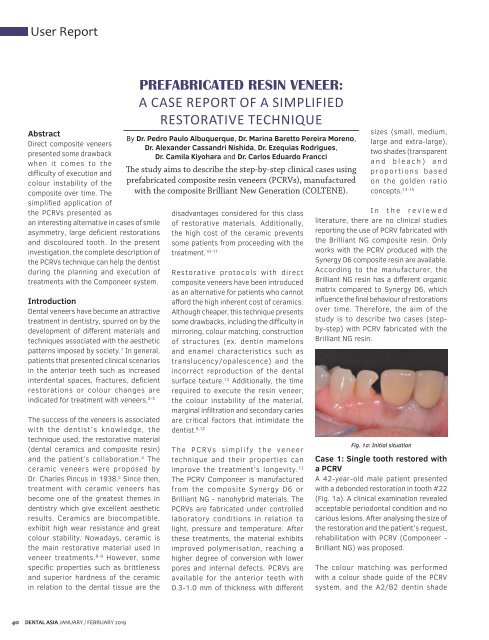Dental Asia January/February 2019
For more than two decades, Dental Asia is the premium journal in linking dental innovators and manufacturers to its rightful audience. We devote ourselves in showcasing the latest dental technology and share evidence-based clinical philosophies to serve as an educational platform to dental professionals. Our combined portfolio of print and digital media also allows us to reach a wider market and secure our position as the leading dental media in the Asia Pacific region while facilitating global interactions among our readers.
For more than two decades, Dental Asia is the premium journal in linking dental innovators
and manufacturers to its rightful audience. We devote ourselves in showcasing the latest dental technology and share evidence-based clinical philosophies to serve as an educational platform to dental professionals. Our combined portfolio of print and digital media also allows us to reach a wider market and secure our position as the leading dental media in the Asia Pacific region while facilitating global interactions among our readers.
Create successful ePaper yourself
Turn your PDF publications into a flip-book with our unique Google optimized e-Paper software.
User Report<br />
Abstract<br />
Direct composite veneers<br />
presented some drawback<br />
when it comes to the<br />
difficulty of execution and<br />
colour instability of the<br />
composite over time. The<br />
simplified application of<br />
the PCRVs presented as<br />
an interesting alternative in cases of smile<br />
asymmetry, large deficient restorations<br />
and discoloured tooth. In the present<br />
investigation, the complete description of<br />
the PCRVs technique can help the dentist<br />
during the planning and execution of<br />
treatments with the Componeer system.<br />
Introduction<br />
<strong>Dental</strong> veneers have become an attractive<br />
treatment in dentistry, spurred on by the<br />
development of different materials and<br />
techniques associated with the aesthetic<br />
patterns imposed by society. 1 In general,<br />
patients that presented clinical scenarios<br />
in the anterior teeth such as increased<br />
interdental spaces, fractures, deficient<br />
restorations or colour changes are<br />
indicated for treatment with veneers. 2-3<br />
The success of the veneers is associated<br />
with the dentist’s knowledge, the<br />
technique used, the restorative material<br />
(dental ceramics and composite resin)<br />
and the patient’s collaboration. 4 The<br />
ceramic veneers were proposed by<br />
Dr. Charles Pincus in 1938. 5 Since then,<br />
treatment with ceramic veneers has<br />
become one of the greatest themes in<br />
dentistry which give excellent aesthetic<br />
results. Ceramics are biocompatible,<br />
exhibit high wear resistance and great<br />
colour stability. Nowadays, ceramic is<br />
the main restorative material used in<br />
veneer treatments. 8-9 However, some<br />
specific properties such as brittleness<br />
and superior hardness of the ceramic<br />
in relation to the dental tissue are the<br />
PREFABRICATED RESIN VENEER:<br />
A CASE REPORT OF A SIMPLIFIED<br />
RESTORATIVE TECHNIQUE<br />
By Dr. Pedro Paulo Albuquerque, Dr. Marina Baretto Pereira Moreno,<br />
Dr. Alexander Cassandri Nishida, Dr. Ezequias Rodrigues,<br />
Dr. Camila Kiyohara and Dr. Carlos Eduardo Francci<br />
The study aims to describe the step-by-step clinical cases using<br />
prefabricated composite resin veneers (PCRVs), manufactured<br />
with the composite Brilliant New Generation (COLTENE).<br />
disadvantages considered for this class<br />
of restorative materials. Additionally,<br />
the high cost of the ceramic prevents<br />
some patients from proceeding with the<br />
treatment. 10-11<br />
Restorative protocols with direct<br />
composite veneers have been introduced<br />
as an alternative for patients who cannot<br />
afford the high inherent cost of ceramics.<br />
Although cheaper, this technique presents<br />
some drawbacks, including the difficulty in<br />
mirroring, colour matching, construction<br />
of structures (ex. dentin mamelons<br />
and enamel characteristics such as<br />
translucency/opalescence) and the<br />
incorrect reproduction of the dental<br />
surface texture. 12 Additionally, the time<br />
required to execute the resin veneer,<br />
the colour instability of the material,<br />
marginal infiltration and secondary caries<br />
are critical factors that intimidate the<br />
dentist. 8,12<br />
The PCRVs simplify the veneer<br />
technique and their properties can<br />
improve the treatment’s longevity. 13<br />
The PCRV Componeer is manufactured<br />
from the composite Synergy D6 or<br />
Brilliant NG - nanohybrid materials. The<br />
PCRVs are fabricated under controlled<br />
laboratory conditions in relation to<br />
light, pressure and temperature. After<br />
these treatments, the material exhibits<br />
improved polymerisation, reaching a<br />
higher degree of conversion with lower<br />
pores and internal defects. PCRVs are<br />
available for the anterior teeth with<br />
0.3-1.0 mm of thickness with different<br />
sizes (small, medium,<br />
large and extra-large),<br />
two shades (transparent<br />
and bleach) and<br />
proportions based<br />
on the golden ratio<br />
concepts. 13-15<br />
In the reviewed<br />
literature, there are no clinical studies<br />
reporting the use of PCRV fabricated with<br />
the Brilliant NG composite resin. Only<br />
works with the PCRV produced with the<br />
Synergy D6 composite resin are available.<br />
According to the manufacturer, the<br />
Brilliant NG resin has a different organic<br />
matrix compared to Synergy D6, which<br />
influence the final behaviour of restorations<br />
over time. Therefore, the aim of the<br />
study is to describe two cases (stepby-step)<br />
with PCRV fabricated with the<br />
Brilliant NG resin.<br />
Fig. 1a: Initial situation<br />
Case 1: Single tooth restored with<br />
a PCRV<br />
A 42-year-old male patient presented<br />
with a debonded restoration in tooth #22<br />
(Fig. 1a). A clinical examination revealed<br />
acceptable periodontal condition and no<br />
carious lesions. After analysing the size of<br />
the restoration and the patient’s request,<br />
rehabilitation with PCRV (Componeer -<br />
Brilliant NG) was proposed.<br />
The colour matching was performed<br />
with a colour shade guide of the PCRV<br />
system, and the A2/B2 dentin shade<br />
40<br />
DENTAL ASIA JANUARY / FEBRUARY <strong>2019</strong>


















